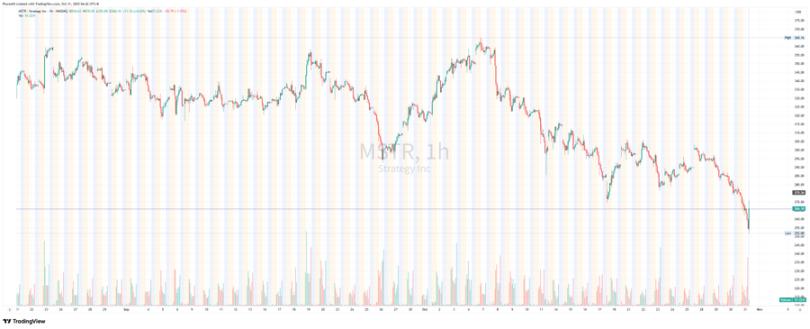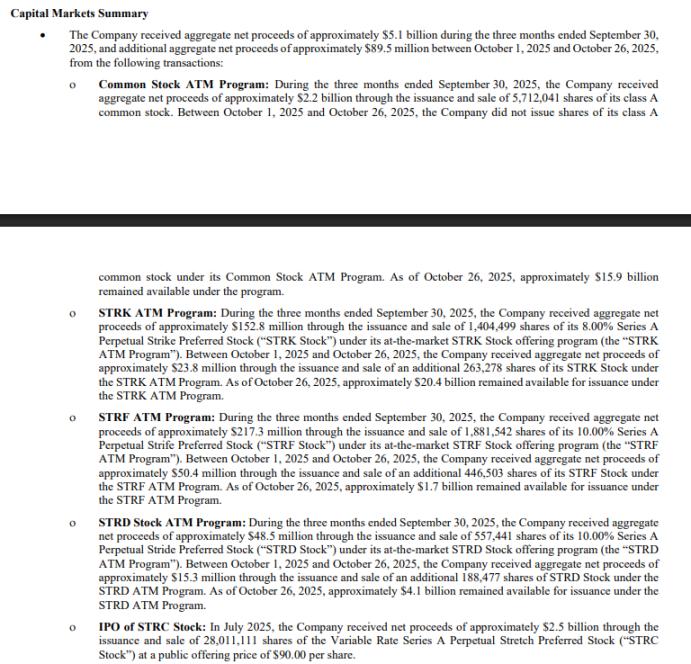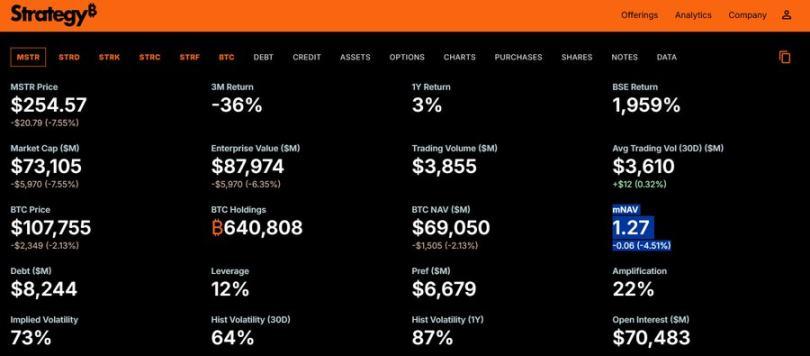Author: Phyrex Source: X, @Phyrex_Ni
As a preface, MSTR released its earnings report after the US stock market closed on Thursday, with earnings per share of $8.42, exceeding market expectations of $7.90. Third-quarter revenue was $128.7 million, exceeding market expectations of $118.3 million. MSTR's third-quarter earnings exceeded market expectations, and its after-hours price rose by more than 5%.

As of October 26, 2025, MSTR held a total of 640,808 Bitcoins (BTC), with a total cost of $47.44 billion, equivalent to a cost of $74,032 per Bitcoin. With the current BTC price at $107,300, this represents a paper profit of $21.333 billion. The net profit (paper profit) for the third quarter was $2.8 billion.
What does this mean?
American Express, ranked 67th globally by assets in the S&P 500, reported a profit of $2.9 billion in the third quarter of 2025. Another well-known technology company, Oracle, also reported a GAAP net profit of $2.9 billion in the third quarter.
This doesn't mean MSTR is particularly impressive. MSTR received a B- junk stock rating in the latest S&P ratings, mainly because Bitcoin's price volatility is too high. So I think S&P's rating for MSTR is basically the same as its rating for BTC, except that BTC can be rated one or two levels higher because there is no leverage.
Therefore, MSTR's net profit (on paper) has basically met the standards of the world's top 100 companies, mainly due to the price of BTC.
crisis?
As of September 30, 2025, MSTR held $54.3 million in cash and cash equivalents. Does this mean it can only buy $54.3 million worth of Bitcoin?
No, MSTR doesn't buy BTC with cash. It buys BTC through capital structure, converting fiat currency into BTC by issuing stocks, bonds, and structured credit.

In fact, the financial report for the third quarter of 2025 showed that as of October 26, 2025, MSTR had a remaining issuance quota of approximately US$42.1 billion through multiple ATM programs. In other words, MSTR could buy up to US$42.1 billion worth of Bitcoin.
So why did MSTR slow down its BTC purchases in the third quarter?
MSTR has divided the Common Stock ATM Program (with approximately $15.9 billion remaining) into three tiers, determining the issuance intensity and use based on mNAV levels:
A. mNAV threshold < 2.5x tactical issuance
Pay debt interest
Subsidized Preferred Stock Dividends
Other favorable circumstances for the company (such as a small cash replenishment).
The issuance size is limited to avoid excessive dilution at low premiums.
B. mNAV threshold 2.5x - 4.0x Opportunistically issued, primarily for purchasing Bitcoin. Funding is balanced with BTC yield, depending on market opportunities.
C. mNAV threshold > 4.0x: Actively issue large amounts of Bitcoin for purchase. Accelerate during high premiums to maximize leverage.

Currently, mNAV is 1.27x (below 2.5x), so MSTR is likely being used primarily for debt/dividend payments rather than for large-scale BTC purchases. This explains the slowdown in buying in the third quarter (only $2.2 billion).
What is the formula for calculating mNAV?
MSTR's mNAV is a multiple of Enterprise Value (EV) divided by the net asset value of Bitcoin holdings (Bitcoin NAV).
Enterprise Value (EV): The total value of a company, including market capitalization + debt + nominal value of preferred stock - cash.
Bitcoin NAV: The market value of Bitcoin held by the company (currently approximately 640,000 BTC, worth over $70 billion).
Will MSTR suddenly collapse?
Low probability in the short term (2026): Unless BTC crashes by more than 50%, the company has $42.1 billion in ATM credit available for rapid financing and stable operating cash flow.
Long-term (2028) probability moderate: If BTC remains sluggish for an extended period, the pressure of debt maturing will be significant (the first large sum will be in 2028). Statistics show that unless the price falls below $16,500, the risk of bankruptcy is highest.
In fact, the price of BTC is not the main reason why MSTR might go bankrupt. If MSTR really goes bankrupt, the core reason should be that MSTR can no longer print shares to exchange for BTC. As long as the market still recognizes MSTR's approach and provides MSTR with financing channels, then the probability of MSTR going bankrupt will be very low.
When is MSTR safest?
BTC is in a fluctuating upward cycle.
Improved liquidity at the Federal Reserve may lead to expectations of interest rate cuts.
The fiat capital market is willing to buy BTC exposure.
Increased US regulatory approval for BTC
If mNAV > 2.5, the company can continue to strengthen its balance sheet.
Non-debt repayment period
From my personal perspective, firstly, there's no need to consider repaying debts before 2028. In other words, the price of BTC before 2028 is unlikely to cause a BTC crash. Secondly, 2028 marks the beginning of a new major cycle, with both the US presidential election and a period of low interest rates in the US, and there's even the possibility of further monetary easing. Liquidity is highly likely to be better than it is now.
Therefore, I think the debt in 2028 is not a problem, and the price of BTC should not be a problem either. As the only Bitcoin asset currently listed on the US stock market, the probability of MSTR defaulting in the next cycle is quite low.
PS: MSTR operates on a cycle of leveraging market confidence → driving up BTC → increasing mNAV → enhancing financing capabilities → buying more BTC. This is a Soros-style reflexive model, not an asset-backed model.








